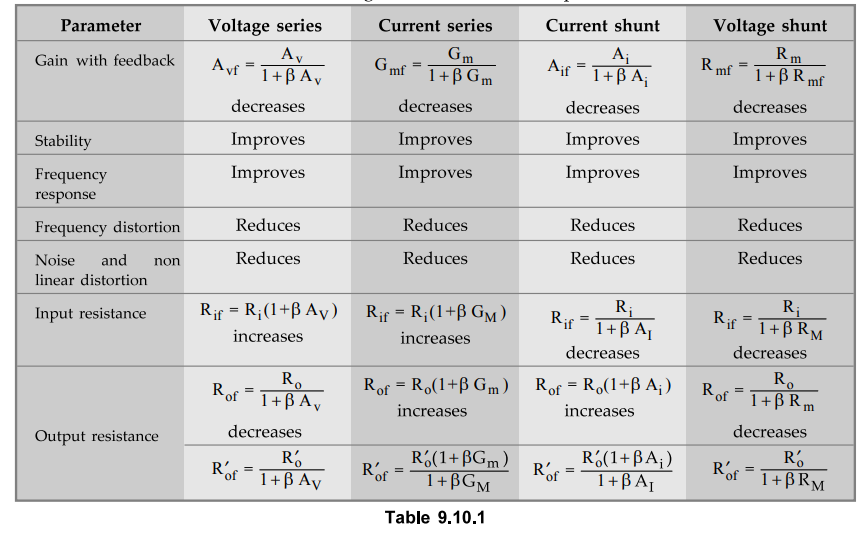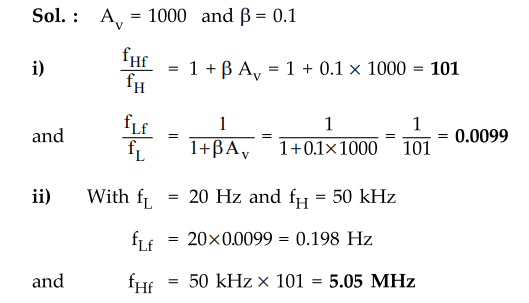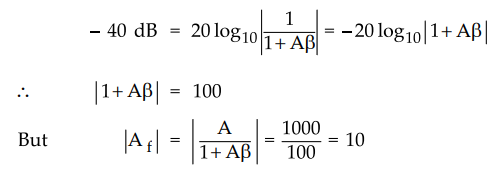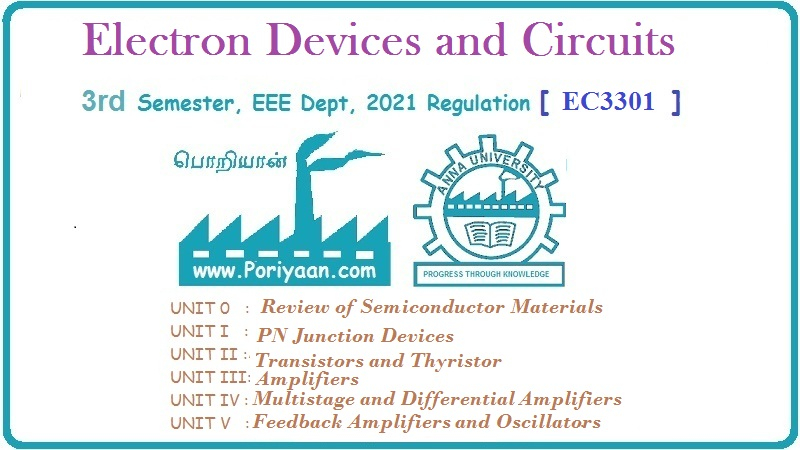Electron Devices and Circuits: Unit V: (a) Feedback Amplifiers
Summary of Effect of Negative Feedback on Amplifier
Solved Example Problems
• Table 9.10.1 summarizes the effect of negative feedback on amplifier.
Summary of Effect of Negative Feedback on Amplifier
•
Table 9.10.1 summarizes the effect of negative feedback on amplifier.

Ex.
9.10.1 Determine the gain with feedback for the amplifier with open loop gain
of 300 and feedback factor of 0.1.
AU
: ECE : Dec.-09, Marks 2
Sol.

Ex.
9.10.2 The gain and distortion of an amplifier are 100 and 4 % respectively. If
a negative feedback with P = 0.3 is applied, find the new distortion in the
system.
AU
: ECE : Dec.-04, Marks 5
Sol.: D = 1 + β Av = 1 + 0.3 × 100= 31
Distortion
= 4% / 31 = 0.129 %
Ex.
9.10.3 The distortion in an amplifier is found to be 3 %, when the feedback
ratio of negative feedback amplifier is 0.04. When the feedback is removed, the
distortion becomes 15 %. Find the open loop and closed loop gain.
AU
: ECE : May-05, Marks 2
Sol.
:
Distortion
with feedback = Distortion without feedback / D
3
% = 15% / D
D
= 5
we
have, D = 1 + Av β
5
= 1 + Av × 004
Av
= 100
Avf
= Av / 1 + Av β = Av / D = 100 / 5 = 20
Ex.
9.10.4 A voltage series feedback amplifier has a voltage gain with feedback as
83.33 and feedback ratio as 0.01. Calculate the voltage gain of the amplifier
without feedback.
AU
: ECE : Dec.-06, Marks 2
Sol.
:
Given : Avf = 83.33 β = 0.01
We
know that,
Avf
= A / 1 + A β
83.33
= A / 1 + 0.01 A
83.33
+ 0.8333 A = A
A
= 500
The
voltage gain of the amplifier without feedback is 500.
Ex.
9.10.5 An amplifier has a midband gain of 125 and a bandwidth 250 kHz.
1)
If 4 % negative feedback is introduced, find the new bandwidth and gain.
2)
If the bandwidth is to be restricted to 1 MHz find the feedback ratio.
AU
: ECE : Dec.-06, 11, Marks 6
Sol.

Ex.
9.10.6 An amplifier has a voltage gain of 1000. With negative feedback, the
voltage gain reduces to 10. Calculate the fraction of the output, that is
feedback to the input.
AU
: ECE : May-07, Marks 2
Sol.
: Given : Av = 1000, Avf = 10
Avf
= A / 1+ Aβ
10
= 1000/ 1 + 1000 × β
β
= 0.099
Ex.
9.10.7 An amplifier with negative feedback give an output of 12.5 V with an
input of 1.5 V. When feedback is removed, it requires 0.25 V input for the same
output. Find
1)
The value of voltage gain without feedback
2)
Value of feedback β if the input and output are in phase and β is real.
Sol.
:

Ex.
9.10.8 An amplifier, without feedback, has a voltage gain of 400, lower cut-off
frequency fi = 50 Hz, upper cut-off frequency f2 = 200 kHz and a distortion of
10 %. Determine the amplifier voltage, gain, lower cut-off frequency and upper
cut-off frequency and distortion, when a negative feedback is applied with
feedback ratio of
Sol.
:

Ex.
9.10.9 An amplifier has a mid frequency gain of 100 and a bandwidth of 200 kHz.
1.
What will be the new bandwidth and gain, if 5 % negative feedback is introduced
?
2.
What should be the amount of feedback, if the bandwidth is to be restricted to
1 MHz ?
Sol
:

Ex.
9.10.10 An amplifier has a voltage gain of 4000. It's input impedance is 2 K
and output impedance is 60 K. Calculate the voltage gain, input and output
impedance of the circuit is 5 % of the feedback is fed in the form of series
negative voltage feedback.
Sol.
:
The voltage gain with feedback can be given as

In
a voltage series feedback input resistance with feedback is given as

In
a voltage series feedback output resistance with feedback is given as

Ex.
9.10.11 An amplifier is required with a voltage gain of 100 which does not very
by more that 1 %. If it is to use negative feedback with a basic amplifier the
voltage gain of which can vary by 20 %, find the minimum voltage gain required
and the feedback factor.
Sol.
:
Given Avf = 100

Ex.
9.10.12 A single stage RC coupled amplifier has a midhand gain of 1000 is made
into a negative feedback amplifier by feeding 10 % of the output voltage in
series with input opposing.
i)
What is the ratio of half power frequencies with feedback to those without
feedback ?
ii)
If fL = 20 Hz and fH = 50 kHz for the amplifier without
feedback, find the corresponding values after feedback is incorporated.
Sol.
:
Av = 1000 and β = 0.1

Ex.
9.10.13 An amplifier with an open loop voltage gain of 1,000 delivers 10 W of
output power at 10 percent second harmonic distortion when the input single is
10 mV. If 40 dB negative voltage series feedback is applied and the output
power is to remain at 10 W, determine : i) The required input signal ii) The
percent harmonic distortion. Sol. : i) 40 dB negative feedback means,
Sol
.:

When
the amplifier delivers 10 W, its output voltage is
Vo
= AvVs = 1000 × (10 × l0-3) = 10 V.
If
the output power is to remain at 10 W, the output voltage also must remain at
10 V. Hence, the input signal required when feedback is applied will be,
Vs
= Vo / Af = 10 V / 10 = 1V
ii)
The distortion of the amplifier with feedback will be reduced by feedback
factor, i.e. by |1 + Aβ| = 100. Hence,
Df
= 10% / 100 = 0.1 %
Ex.
9.10.14 An amplifier has an open loop gain of 100, and its lower and upper
cut-off frequency of 100 Hz and 100 kHz respectively. A feedback network with
feedback factor of 0.99 is connected to the amplifier. Calculate the new lower
and upper cutoff frequencies.
Sol.
:

Examples
for Practice
Ex.
9.10.15 A feedback amplifier has an open loop gain of 600 and feedback factor β
= 0.01. Find the closed loop gain with negative feedback.
AU
: ECE : Dec.-04, Marks 2
[Ans.
: 85.714]
Ex.
9.10.16 An amplifier has mid-band voltage gain ( frimid) °f 1000 withff = 50 Hz
and = 50 kHz, if 5 % feedback is applied then calculate gain ff, and ff[ with
feedback
[Ans.
: fLf = 0.98 Hz, fHf = 2.55 MHz]
Ex.
9.10.17 An amplifier with open loop gain of A = 2000 ± 150 is available. It is
necessary to have the amplifier whose voltage gain varies by not more than ±
0.2 %. Calculate P and Af.
[Ans.
: β = 0.01825, Af = 53.33]
Ex.
9.10.18 An RC coupled amplifier has a voltage gain of 1000, ff = 50 Hz, f2 =
200 kHz and a distortion of 5 %. With feedback find Ayf, BWf when P = 0.01 is
applied.
AU
; ECE : May-08, Marks 5
[Ans.
: AVf = 90.9, BWf = 2.2 MHz, Distortion = 0.4545 %]
Review Questions
1. Compare the four types of feedback topologies with respect to
basic amplifier characteristics.
AU : ECE : Hay-06, Harks 6
2. Discuss the effect of negative feedback with respect to
closed loop gain, bandwidth and distortion.
AU : ECE : Dec.-06, Marks 5
Electron Devices and Circuits: Unit V: (a) Feedback Amplifiers : Tag: : Solved Example Problems - Summary of Effect of Negative Feedback on Amplifier
Related Topics
Related Subjects
Electron Devices and Circuits
EC3301 3rd Semester EEE Dept | 2021 Regulation | 3rd Semester EEE Dept 2021 Regulation
